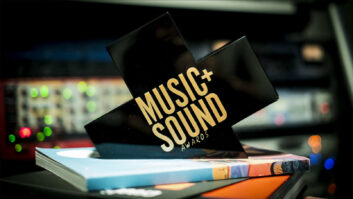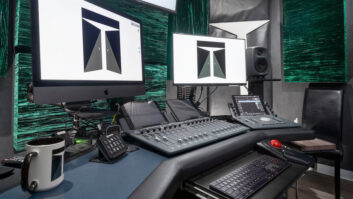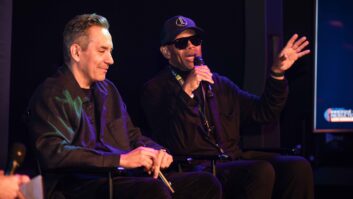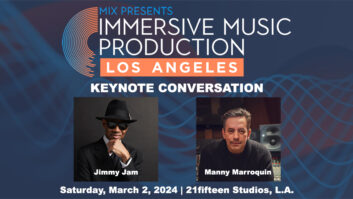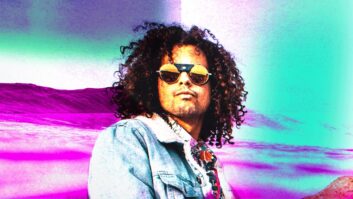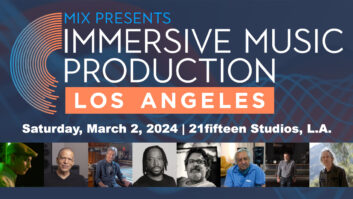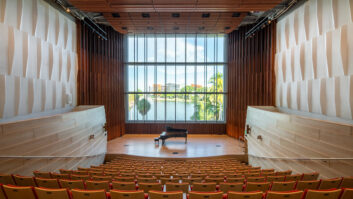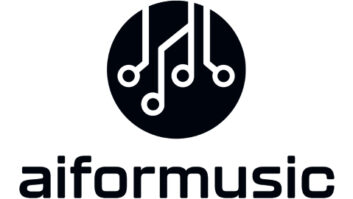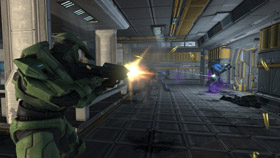
As videogames have become more sophisticated and complex in recent years, so too have their music scores. Long gone are the days of simple scores banged out on solitary keyboards and integrated into the game at the lowest possible bit-rate. Orchestral scores are common for big-budget games, as are hybrid scores that use electronic and/or percussion elements, rock and other music forms, as well as orchestrated passages. With some top games requiring two or more hours of music, there has been plenty of work for large and small studios to keep up with the demand, and musicians and singers are finding a new source of income for their talents.
Take, for example, two wildly different games that were released on November 15 by Microsoft Games Studios for Xbox 360: Halo: Combat Evolved Anniversary and Kinect Disneyland Adventures. Both of these certain hits shared the same audio director (Microsoft’s Kristofor Mellroth), music production company (Pyramind Studios of San Francisco) and recording facilities (a combination of Pyramind and, for each game’s orchestral score, Skywalker Sound in Marin County, Calif.). Yet each project had so many unique challenges dictated by enormous differences between the two games, it’s difficult to make generalizations about what is required from a music recording standpoint at this upper level of what is known as Triple-A gaming.
HALO REDUX
Halo: Combat Evolved Anniversary is something unusual in the game world—a complete remastering and revisiting of a classic first-person shooter game. Bungie’s original Halo title was the flagship game for the Microsoft Xbox format, released 10 years ago to the day of the Anniversary edition. The new version, developed by 343 Industries, hews very closely to the original but with greatly enhanced graphics, plus improved audio and a complete reinterpretation of Martin O’Donnell and Michael Salvatori’s famous score—so instantly recognizable to gamers for its chanting monks and driving synth cellos.

Recording Chanticleer at Pyramind Studios for Halo: Combat Evolved Anniversary. From left: Peter Steinbach, Paul Lipson, Steve Heithecker, Matthew Oltman, Kristofor Mellroth
“It’s my favorite game of all time,” says Microsoft’s Kris Mellroth. “It was a landmark game, not just for gameplay, but for audio as well. It also has that super-iconic score. So it was a little nerve-racking [remaking it], and I wanted to make sure we got it right, so I wanted to have a team I knew would treat the music with respect. We weren’t there to second-guess what was done before; we were there to make a super-high-quality remaster of what’s there. In a way, it’s a love letter to the original. I’m such a fan of Marty and of [original sound designer] Jay [Weinland], and I played Halo I so many times.”
With Pyramind’s long history of top-quality music and audio work for games by so many major game-makers—including Ubisoft, LucasArts, Sony Entertainment, Electronic Arts and Microsoft Games—it was a natural choice for Mellroth when he was a looking for a one-stop shop that could handle music, audio post, implementation, mixing and mastering. Between Pyramind audio director/composer/COO Paul Lipson and founder/CEO/mixer/mastering engineer Gregory Gordon (and their team in their downtown S.F. studios), they had all the bases covered.
“The original Halo score was mostly sample-based,” Lipson says, as he and Gordon sit in Lispson’s studio/office, “and there was no sheet music at all. I was given a file directory for the in-game music, and then Lennie Moore [a well-known composer and orchestrator in the gaming world] and I transcribed every single note of the score and re-orchestrated a lot of it.” As Mellroth notes, “If we could find a way to enhance something—say, add some brass for this passage—we were going to do it.”
The score’s non-orchestral portions were tracked mostly at Pyramind, including new guitar performances by Lipson and Bryan Dale, some bold synth work spearheaded by Brian Trifon, and percussion elements “virtualized” by Lipson and New York musician/composer Tom Salta, a longtime collaborator with Pyramind. “We did record a live drummer for a few tracks at our studios here,” Lipson says, “and I know Tom brought in a live percussion player to blend in, as well, but most of it was created using custom samples and sequencing.”
Then there were the monks. For Anniversary, Pyramind hired what Lipson calls “the finest vocal ensemble in the world,” the San Francisco–based all-male group Chanticleer, who had never sung on a videogame before. “The monks are the most iconic thing in the score, so it was important that they sound really powerful. As a longtime fan of Chanticleer, I was thrilled to get to record them here at Pyramind Studios.”

Chanticleer and the Pyramind Studios team for Halo: Combat Evolved Anniversary. From left, front: Lennie Moore, Cortez Mitchell, Adam Ward, Brian Hinman, Gregory Peebles, Paul Lipson, Kristofor Mellroth, Jace Wittig, Peter Steinbach, Michael Axtell, Eric Alatorre. From left, rear: Matthew Oltman, Matthew Curtis, Ben Jones, Steve Heithecker, Michael McNeil, Casey Breves, Alan Reinhardt, Michael Roache
SKYWALKER SESSIONS
The orchestral sessions took place on Skywalker Sound’s enormous 60x80x30 Scoring Stage over five days this past June, with the studio’s director of music recording and scoring, Leslie Ann Jones, engineering and Lipson producing. Pyramind’s Michael Roache was production coordinator, and Skywalker’s Andre Zweers was the primary Pro Tools operator. The group known as the Skywalker Symphony Orchestra—contracted for the sessions by Janet Ketchum—is made up primarily of players from the San Francisco Symphony, Opera and Ballet Orchestras, but also draws from the Marin Symphony and the Oakland East Bay Symphony. This is a union gig, so it does not come cheaply, but not long ago, game-makers managed to cut a special deal with the American Federation of Musicians in which musicians are paid more up front for videogame music sessions to compensate for the fact that there are no “back-end” residuals as there are for TV and film. Conducting was noted game music composer and conductor Wataru Hokoyama.
For the Halo sessions at Skywalker, the strings were recorded separately from the brass and woodwinds on alternating days in different sessions so there would be greater flexibility in the mixes. “The cellos played a crucial role in the score and needed to be very prominent in the mixes, so isolation was very important,” says Gordon. Jones and her team still set up the room as if a full orchestra would be playing at once—with strings in front, brass in the rear and a slightly baffled middle section for woodwinds—and assigning spot, section and room mics accordingly. Among the mics Jones selected were C12s for first and second violins; U67s for violas; KM84s for celli; and M49s for double-bass, all through Neve 1081 console-controlled preamps. Other models included Neumann KM 140s for flutes, oboes, clarinets and bassoon, also through the Neve preamps; Neumann TLM 170s on trumpets; U87s on trombones; two M149s and a KM 143 on the French horns (front left/right and rear, respectively); and a Neumann M147 on tuba, all through Grace 801R preamps. There were also two high L/C/R “trees” up front and center for an overall view of the strings; one had three Neumann M50s going through GML preamps, the other was testing the new Telefunken 261s through John Hardy Jensen pre’s (“hung adjacent to M50s so I could compare them,” Jones says). Additionally, Jones put up a pair of wide mics, surrounds, a mic dedicated to LFE and a pair of Neumann KM133D (digital mics) “as an experiment to get a mid-room sound of the brass.”
Everything was recorded through the studio’s Neve 88R console to Pro Tools|HD at 24-bit/96k—though because of limitations in the original Halo engine, the music appears in the Anniversary game at 16/48. Lipson and Andre Zweers executed the session edits, and then all the various stems and sessions from Skywalker and Pyramind went to Gordon, who mixed and mastered all of the in-game music, as well as the double-CD soundtrack and the limited-edition vinyl release.
“What happens with games like these is the cue count goes through the roof and the number of files you have to keep track of and the asset management required is phenomenal,” Gordon says. “This is why we have a full-time project manager to keep track of all the different takes and which tracks and stems go with which, because you’re recording material in one studio that needs to get mixed with material from another, so we’re very fortunate to have Michael Roache there every step of the way.”

VIRTUAL DISNEYLAND
Kinect Disneyland Adventures was perhaps an even more complicated and involved project for Pyramind and Skywalker. The game, created by the UK’s Frontier Developments, is the latest to employ Microsoft’s proprietary Kinect technology (introduced a year ago), an interactive motion-sensitive gaming environment along the lines of Wii Remote Plus and PlayStation Move, but requiring no controller other than a moving body. The Disneyland game allows players to experience many cherished attractions at Disneyland—the Matterhorn Bobsleds, Pirates of the Caribbean, Big Thunder Mountain Railroad, the Haunted Mansion, Space Mountain, the Jungle Cruise, et al—and interact with some 40 Disney characters, as well as conduct the Disneyland Parade. It also features wall-to-wall music—more than 300 minutes of newly orchestrated and performed versions of numerous beloved Disney themes, along with new music composed in the spirit and style of classic Disney.

The Kinect Disneyland Adventures team with the Skywalker Symphony Orchestra. From left: André Zweers, Leslie Ann Jones, Lennie Moore, Janet Ketchum, Laura Karpman, Gregory J. Gordon, Michael Roache, Paul Lipson, Mark Griskey, Peter McConnell, Wataru Hokoyama
With a fiendishly short 75-day window to work within, Mellroth turned to Pyramind and charged Lipson with being both the producer and lead composer. To meet the tight timeline to complete the mammoth task of creating the music for Kinect Disneyland Adventures (KDA for short), Lipson assembled a team of five additional composers. There was some overlap with the Halo team, including Lipson, Wataru Hokoyama and Lennie Moore contributing various pieces, along with established game composers Laura Karpman, Peter McConnell and Mark Griskey. Lipson carefully matched each composer’s talents (and preferences) to the myriad styles required—after all, this music spans the entire history of Disney films (and theme park attractions), from the late 1930s to the present, and styles ranging from lush orchestral pieces of the first “Golden Age” to modern pop nuggets by Alan Menken, Randy Newman and others, as well as sometimes whimsical diversions into bluegrass and various ethnic music styles for specific rides.
“Everyone had to be able to compose idiomatically,” Lipson comments. “When you’re touching some of these franchises that have been around for years, for decades even, everybody’s looking and you have to get it right. But that’s the trust we had from Disney and Microsoft. And that’s why I called the people I did. They understand the idiom, and I knew I could trust them to do this without over-coloring it.”

The Kinect Disneyland Adventures team, from left: Mark Griskey, Lennie Moore, Laura Karpman, Paul Lipson, Leslie Ann Jones, Peter McConnell, Wataru Hokoyama, André Zweers, Michael Roache
The orchestral sessions for KDA at Skywalker in mid- to late August and the beginning of September 2011 were longer and more involved than the ones for Halo Anniversary, including 12 three-hour sessions with a 79-piece orchestra, and others with what Jones calls “the B-band—27 players, just strings and woodwinds.” Rather than recording strings and woodwinds and brass separately as they had on Halo, Jones says, “On KDA, everybody was playing at the same time, including the percussion, so the only things you could separate from that were if the strings doubled, or if the percussion had extra parts they overdubbed, or any of the pre-layed percussion the composers came with.
“For some of it that had that ’50s-style orchestration, we were looking for an older sort of sound rather than something that’s very pristine and hi-fi,” Jones continues. “For KDA, we ended up using C-12s for the strings and ribbon mics for the brass—I use Wes Dooley mics, I use Royers, I use Coles—because we wanted a sound that was full, but not terribly ambient and not too dry.”
The different composers would be on hand for the days on which their pieces were recorded—on the day I visited, Laura Karpman was in the control room at Skywalker, standing to Jones’ left, carefully following the score as the orchestra—with Wataru Hokayama conducting—went through its paces. Occasionally she would communicate a minute change to an arrangement through the conductor, and there were also instances where musicians would ask questions about a specific note or rest. Lipson was at Jones’ right at the Neve, also examining the score and listening for problems. During the hours I was there, few anomalies showed up—the Skywalker Symphony moved from piece to piece with remarkable precision and alacrity. You could almost feel the euphoria of Disney Magic in the control room.

Wataru conducts the Skywalker Symphony Orchestra
“All these scores hit the stage the day we were recording them,” says Gordon, who was also on hand that day at Skywalker. “Wataru was sight-reading all the conducting as it went down the whole way through, just as the orchestra was sight-reading it. It was so impressive.”
INTERACTIVITY
After the orchestral recording for KDA was completed, Pyramind once again became the site of some smaller sessions for other parts of the score, including a bluegrass group that had to be mixed into the orchestral base of the Big Thunder Mountain Railroad section. Even more challenging was the Disney Soundsational Parade.
“For that one,” Lipson says, “I had to take a bunch of beloved Disney melodies—‘Under the Sea’ and some of those beautiful Menken melodies, along with Peter Pan, Mickey Mouse and others—and arrange them for brass and also make it interactive, because in that part of the game, [the player] conducts the music, and how it sounds depends on how well it’s being conducted. So when we were recording, I had to say something to the musicians I’ve never said before on a project, which was, ‘Give me your worst!’ Because I had to track the success of you conducting well and also you not doing well. The result is astounding. It will move out of bad playing and good playing depending on how you’re doing. It’s hilarious.”
Jones mixed the large “A-band” orchestral sessions on the Neve 88R at Skywalker and then the smaller “B-band” cues (the 27-piece group) went into the game directly from the 2-track mixes she made at the time she recorded them. Gordon mastered the entire score, which was the single largest either Pyramind or Skywalker had ever worked on.
“More than just about any game I know, the score is front and center [in KDA],” Lipson says. “The music drives the game audio. In every single attraction, the music is important.”
